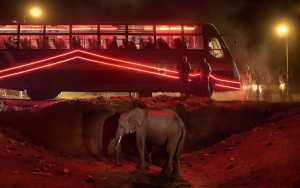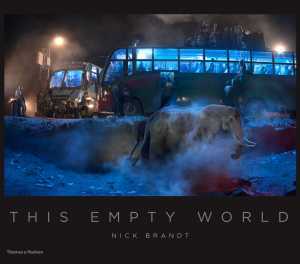Every shot in this striking new series of photographs by British photographer Nick Brandt is a combination of two moments in time captured weeks apart, almost all from exactly the same camera position.
Combining pictures of vulnerable animal life with lurid imagery of industrial work being done in their habitats, each photo demonstrates humanity's encroachment on the natural world with its industrial and architectural projects.
To take each photo, a partial set was built and lit. After that, weeks and sometimes even months followed while the animals inhabiting the region became comfortable enough with the additions to the scenery to enter Brandt's frame.
Once the animals were captured on camera, Brandt and his team completed their sets in the same location of the original photograph, depicting the encroachment of humans – petrol stations, motorways and construction sites – that are invading many parts of the East African landscape.

A second sequence of shots was then photographed with the completed set, populated by a large cast of people drawn from local communities.
The resulting images, which make up the This Empty World series, are disturbing and beautiful panoramic composites of the two photographs, presenting the wild animals and the people as equal victims in the destruction of the natural world around them.

The entire project was shot on unprotected inhabited land in East Africa, and all elements of sets were recycled and the land returned to its former state after shooting.
Want to see how the project came together – take a look at the Behind The Scenes shot above, which explains the process of set-building and capturing both photos in the final composite image. More information can be found about Nick Brandt here.
Interested? Nick Brandt's series of This Empty World photographs are being exhibited at Waddington Custot in London (W1S 3LT) until Thursday 7 March. waddingtoncustot.com

